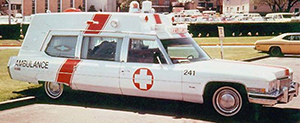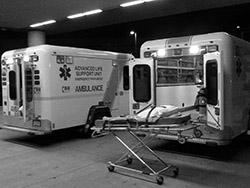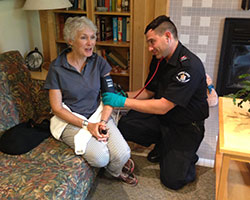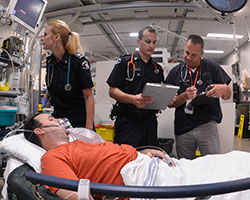A Brief History
 In 1974, the British Columbia Government created the BC Ambulance Service, in response to problems with ambulance services differing significantly from community. At the time, small private ambulance providers created at patchwork of coverage. Citizens couldn’t reliably know that when they were in crisis, a Paramedic staffed ambulance would be available to them.
In 1974, the British Columbia Government created the BC Ambulance Service, in response to problems with ambulance services differing significantly from community. At the time, small private ambulance providers created at patchwork of coverage. Citizens couldn’t reliably know that when they were in crisis, a Paramedic staffed ambulance would be available to them.
The creation of a provincial ambulance service aimed to ensure all British Columbians would have reliable ambulance services at their disposal. This model proved to be years ahead of its time, as many other provinces are transitioning to such a structure only now. A provincial service removes any artificial boundaries, allowing resources to be shared from community to community.
Current Challenges
Today, British Columbia faces a new struggle with ambulance services. Many small to medium sized British Columbia communities are facing serious Paramedic recruitment and retention problems. Low emergency call volumes prevent adequate funding to justify the expense of full time Paramedic staffing. The withdrawal of locally funded Paramedic training has resulted in a steep decline of applicants for rural communities. Today, we face critical staffing shortages across the province.
 This staffing shortage leaves many communities facing long periods of time with reduced or no ambulance service at all. With an aging population, it is even more important that all British Columbians have an active and reliable ambulance service in their community. Along with staffing shortages, the regionalization of more and more healthcare services means patients face longer and longer travel times to receive the care they need.
This staffing shortage leaves many communities facing long periods of time with reduced or no ambulance service at all. With an aging population, it is even more important that all British Columbians have an active and reliable ambulance service in their community. Along with staffing shortages, the regionalization of more and more healthcare services means patients face longer and longer travel times to receive the care they need.
The BC Ambulance Service must respond to these challenges by adapting to local needs and ensuring a reliable service to connect patients to the care they require.
Community Based Solutions
No two communities have the same ambulance and healthcare problems, so solutions must be found which fit each specific area’s need. BC Paramedics are a key part of BC’s healthcare team and can be part of those solutions. Recent projects in Burns Lake and Midway are examples of how the BCAS, the Health Authority and the Paramedics union can work collaboratively to find unique solutions.
Successful Community Paramedic programs are being used across Canada to keep small hospitals open, keep seniors living in their own homes, reduce travel for medical services, provide high quality emergency ambulance coverage and create new jobs to attract qualified Paramedics. Some examples of rural successes are:
 CREMS Program – Community Referrals by EMS (CREMS) is being used to identify seniors at risk of losing their independence or suffering a serious medical event at home. The focus is on identifying patients at risk and then referring those patients to the specific type of care needed to ensure they stay healthy in their own home.
CREMS Program – Community Referrals by EMS (CREMS) is being used to identify seniors at risk of losing their independence or suffering a serious medical event at home. The focus is on identifying patients at risk and then referring those patients to the specific type of care needed to ensure they stay healthy in their own home.
The simple act of providing medical care in a patient’s own home saves staggering amounts of money in the healthcare system. In Ontario, long-term seniors care costs, on average, $60,000 per patient, per year. Using Community Paramedics to provide care to that same patient in their home costs, on average, just $10,000 per year. Multiply that $50,000 savings times 20 patients, and the healthcare system saves $1 million annually.
Community Paramedicine programs are now listed as a ‘key deliverable’ in the Ontario Government Senior Strategy.
 Collaborative Emergency Centres (CECs) – Better Care Sooner Program – In rural areas around Nova Scotia, Community Paramedicine programs are being used to supplement small hospitals and health clinics. These areas suffer physician shortages, which causes hospitals to close. These closures result in patients being forced to travel significant distances to obtain the care they need.
Collaborative Emergency Centres (CECs) – Better Care Sooner Program – In rural areas around Nova Scotia, Community Paramedicine programs are being used to supplement small hospitals and health clinics. These areas suffer physician shortages, which causes hospitals to close. These closures result in patients being forced to travel significant distances to obtain the care they need.
Paramedics, along with nurses, are being used to staff these failing medical centres during the evening and night hours. With a physician available to consult, this new staffing model keeps the hospital open and ensures patients can receive prompt, local, high quality medical care. In seven of these communities they have seen a staggering 92% drop in the number of hours which those hospitals are closed.
This collaborative solution between Paramedics, nurses and physicians is being hailed as the ‘saving grace’ for rural hospitals in Nova Scotia.
These are just two examples of how Community Paramedics can be part of the solution for struggling rural communities. These types of programs also create well paying regular jobs, which attracts qualified Paramedics who have an interest in staying in the rural community for years to come.
In British Columbia, the provincial government has an obligation to provide ambulance services to each and every citizen of the province. This provincial model has been shown as the most efficient delivery model in the industry. In fact, Alberta is currently transitioning from a municipal ambulance model to a BC-style provincial model. Many other provinces are following suit as well.
While the BCAS faces significant struggles in many areas, we must find solutions to those struggles within the provincial structure model. The downloading of ambulance services to municipalities or private companies would take our province back almost 40 years in progress. Such a backward move would simply transfer the obligation and costs of ambulance delivery to municipal tax payers, while failing to solve the real issues.
In order for new programs, such as Community Paramedicine, to be developed, it is critical that the key stakeholders are able to work directly with each other. Currently, the bargaining for Paramedic and Ambulance services occurs within the Facilities Bargaining Association (FBA). Paramedics are a small part of the 45,000 employees encompassed by the FBA. As a result, discussions on Paramedic specific issues are often lost in the larger scheme. This has resulted in year after year of failed progress to resolve ambulance delivery issues. In order to discuss solutions, it is critical that Paramedics be removed from the FBA, into a separate and distinct bargaining association.
Taking Action For Your Community
 Municipal representatives have a critical role in the decisions being made about healthcare services in your community. You know the needs of your community better than anyone else.
Municipal representatives have a critical role in the decisions being made about healthcare services in your community. You know the needs of your community better than anyone else.
It is time that solutions to the ambulance and healthcare issues faced by rural communities come to the forefront of British Columbia government discussions.
We ask that you write both the Health Minister and Health Critic to express your concerns for the state of ambulance services and healthcare in your community.
We ask that you highlight:
- Your unique community issues
- Your support for new programs like Community Paramedicine
- Your support for bargaining structure changes to get these discussions started
We also ask you to spread the word. Share your thoughts and issues with your colleagues around the province. When each and every rural community comes together to demand solutions, big ideas can quickly take shape.
The Ambulance Paramedics of BC is ready to get to work on finding solutions for your community. If you have any further questions about our ideas, or would like to discuss them further, please contact us HERE
